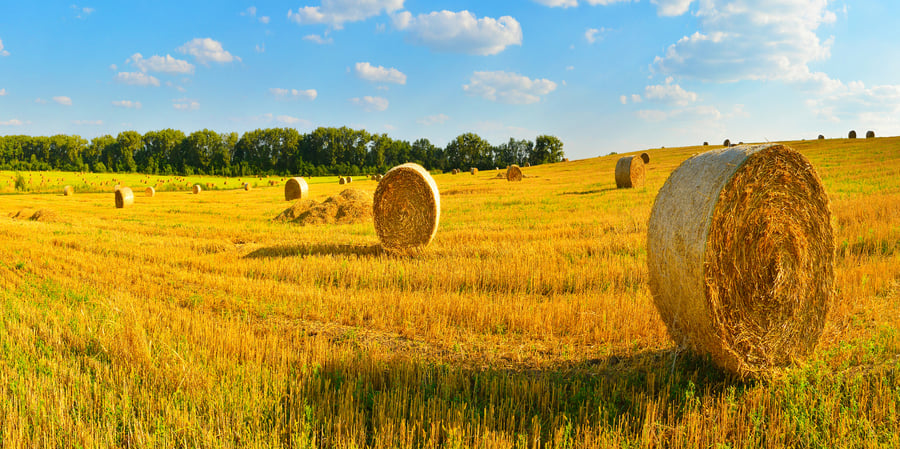moisture meters
hay industry
moisture content in hay
agricultural safety
moisture levels in hay
high-quality moisture meters
agricultural moisture meters
farming moisture meters
How to Get the Most Out of Your Moisture Meter: A Guide for All of Your Hay Needs
.jpg)
The fourth article in our blog series follows from our previous piece that explored Delmhorst’s wide range of moisture meters for hay production and management purposes. Our last article narrowed down the features and advantages of various moisture meter models for particular applications in the hay industry, including exports and optimized quality checks.
Aside from selecting the most suitable moisture meter models, there are some essential procedures that hay producers should consider in optimizing moisture content in hay.
Let’s look at other ways to get the most out of your moisture meter when dealing with hay.
Always Consider Bale Density
Bale density is a critical factor in measuring moisture levels in hay. Generally, loose hay will be more at risk to catch fire than closely packed bales. It is crucial to note that hay might spontaneously combust if internal temperatures reach 130 degrees Fahrenheit. It is vital for producers to monitor moisture levels to avoid the risks of fire.
The size and weight of hay bales impacts their overall density and determines the acceptable moisture content level. Larger bales are usually more densely packed compared to smaller stock. While smaller stock storage is safe with an average 18-20% moisture content, bigger hay bales have a lower tolerance for moisture concentration, requiring moisture levels between 12 to 16%.
Take Multiple Measurements
Hay crops may produce drastically different moisture and temperature readings, with variances attributable to ambient conditions and the position of your hay.
For example, you might detect a tolerable moisture content below 20% for hay located toward the center of your storage facility, but bales left under a tree and away from direct sunlight may have much higher moisture content and even show the beginning signs of browning.
The most reliable method of obtaining a good overall indication of moisture content in hay is to take multiple readings from different angles of the bale, across and between the slices of a square bale or, into the center of a round bale both from the diameter and width of the bale.
Test During Different Hay Processing Stages
It is important to test moisture content in hay at various stages, including in the windrow after cutting and again prior to baling. Take some measurements during baling as well, especially when using on the go monitoring equipment so you can corroborate expected differences between the baler-mounted sensor readings and bale probe readings taken with the hand-held tester. Conditions in the field can change rapidly, and these tests will give a good idea as to how ambient conditions are affecting bale moisture.
Choose a Suitable Moisture Meter for the Hay Industry
As shared in our previous article, choosing a moisture meter optimized for your specific hay application provides accurate readings with top efficiency and cost-effectiveness.
For instance, moisture meters with a short, multi-pin probe can provide you with convenient measurement capabilities for windrow testing. However, you might require specialized meter models with longer coaxial bale probes for the accurate measurement of different hay packages.
Calibrate your Moisture Meters
As with any testing device, it is critical to be sure the meter is in good calibration. Moisture meters come pre-calibrated; however, your equipment may gradually exhibit a dip in accuracy with prolonged use.
A slight deviation from optimal moisture readings may result in differences in hay quality. You should ensure that you keep your meters electrically calibrated for accurate results when assessing hay moisture content. The meter manufacturer should have available an external calibration standard for this purpose, whether or not the meter has an internal check. Keeping the batteries fresh will go a long way in the meter’s calibration lasting for a long time.
Check the User’s Manual
Each moisture meter comes with a user's manual that provides a detailed breakdown of the product features. By checking with the manual, you can better understand the specialized function of your models.
The manual serves as a systematic reference covering multiple topics, including care and maintenance, calibration processes, and other steps required for optimizing moisture measurement. You may rely on the owner manual provided with your device as a trusted guide for resolving the FAQs commonly faced when using your meter.
Delmhorst - Your Trusted Solutions Provider for Specialized Moisture Meters
Delmhorst provides a vast range of premium moisture meters specific to various hay applications. We offer multiple meter configurations and a diverse selection of quality components, such as special application electrodes and prods, providing consistent readings for optimized hay handling and management.
The F-6/6-30 model offers a simplified interface that enables producers to maintain convenient moisture measurement, along with a built-in calibration feature for maintaining accuracy at a glance.
For individuals seeking enhanced functionality, we recommend the FX-2000, with a dual-mode of continuous and portable functions according to specific hay application needs. The model’s continuous mode enables two readings every second, coupled with a built-in backlight for easy monitoring under most lighting conditions.
With the portable mode, you can obtain an average of up to 100 readings while on the move, providing a quick reference to the average and highest reading values, and see how often the dangerous highs occur.
Reach out to Delmohorst’s specialists to discover the most suitable moisture meter catered to your hay needs.
To see more Click below:
https://youtube.com/playlist?list=PLOpH_WF7L15TQLYxqBVkFxP9fU3WEuj-6
Subscribe to Our Blog
Post Related

moisture meters
pinless moisture meter
hay industry
moisture content in hay
hay producers
agricultural safety
moisture levels in hay
high-quality moisture meters
agricultural moisture meters
farming moisture meters
The Benefits of High-Quality Moisture Meters for Hay Producers
.jpg?width=900&name=Webp.net-resizeimage%20(55).jpg)
